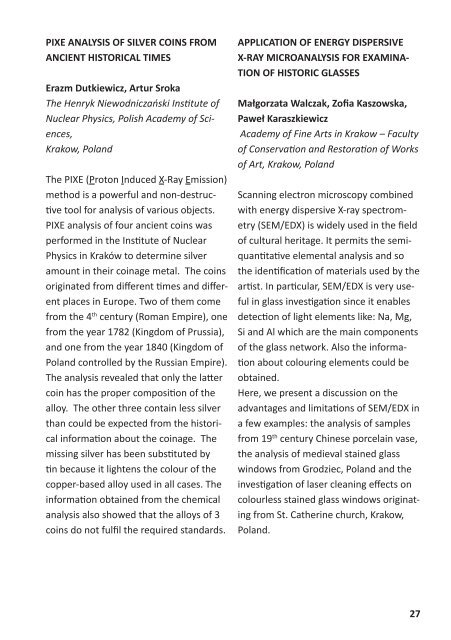4th Meeting X-ray techniques in investigations of the ... - CrysAC
4th Meeting X-ray techniques in investigations of the ... - CrysAC
4th Meeting X-ray techniques in investigations of the ... - CrysAC
Create successful ePaper yourself
Turn your PDF publications into a flip-book with our unique Google optimized e-Paper software.
PIXE ANALYSIS OF SILVER COINS FROM<br />
ANCIENT HISTORICAL TIMES<br />
Erazm Dutkiewicz, Artur Sroka<br />
The �enryk �iewodniczański Institute <strong>of</strong><br />
�uclear Physics� Polish Academy <strong>of</strong> �ciences�<br />
Krakow� Poland<br />
The PIXE (Proton Induced X-Ray Emission)<br />
method is a powerful and non-destructive<br />
tool for analysis <strong>of</strong> various objects.<br />
PIXE analysis <strong>of</strong> four ancient co<strong>in</strong>s was<br />
performed <strong>in</strong> <strong>the</strong> Institute <strong>of</strong> Nuclear<br />
Physics <strong>in</strong> Kraków to determ<strong>in</strong>e silver<br />
amount <strong>in</strong> <strong>the</strong>ir co<strong>in</strong>age metal. The co<strong>in</strong>s<br />
orig<strong>in</strong>ated from di�erent times and di�erent<br />
places <strong>in</strong> Europe. Two <strong>of</strong> <strong>the</strong>m come<br />
from <strong>the</strong> 4 th century (Roman Empire), one<br />
from <strong>the</strong> year 1782 (K<strong>in</strong>gdom <strong>of</strong> Prussia),<br />
and one from <strong>the</strong> year 1840 (K<strong>in</strong>gdom <strong>of</strong><br />
Poland controlled by <strong>the</strong> Russian Empire).<br />
The analysis revealed that only <strong>the</strong> latter<br />
co<strong>in</strong> has <strong>the</strong> proper composition <strong>of</strong> <strong>the</strong><br />
alloy. The o<strong>the</strong>r three conta<strong>in</strong> less silver<br />
than could be expected from <strong>the</strong> historical<br />
<strong>in</strong>formation about <strong>the</strong> co<strong>in</strong>age. The<br />
miss<strong>in</strong>g silver has been substituted by<br />
t<strong>in</strong> because it lightens <strong>the</strong> colour <strong>of</strong> <strong>the</strong><br />
copper-based alloy used <strong>in</strong> all cases. The<br />
<strong>in</strong>formation obta<strong>in</strong>ed from <strong>the</strong> chemical<br />
analysis also showed that <strong>the</strong> alloys <strong>of</strong> 3<br />
co<strong>in</strong>s do not fulfil <strong>the</strong> required standards.<br />
APPLICATION OF ENERGY DISPERSIVE<br />
X-RAY MICROANALYSIS FOR EXAMINA-<br />
TION OF HISTORIC GLASSES<br />
Małgorzata Walczak, Z<strong>of</strong>ia Kaszowska,<br />
Paweł Karaszkiewicz<br />
Academy <strong>of</strong> �<strong>in</strong>e Arts <strong>in</strong> Krakow – �aculty<br />
<strong>of</strong> Conser�ation and Restoration <strong>of</strong> �orks<br />
<strong>of</strong> Art� Krakow� Poland<br />
Scann<strong>in</strong>g electron microscopy comb<strong>in</strong>ed<br />
with energy dispersive X-<strong>ray</strong> spectrometry<br />
(SEM/EDX) is widely used <strong>in</strong> <strong>the</strong> field<br />
<strong>of</strong> cultural heritage. It permits <strong>the</strong> semiquantitative<br />
elemental analysis and so<br />
<strong>the</strong> identification <strong>of</strong> materials used by <strong>the</strong><br />
artist. In particular, SEM/EDX is very useful<br />
<strong>in</strong> glass <strong>in</strong>vestigation s<strong>in</strong>ce it enables<br />
detection <strong>of</strong> light elements like: Na, Mg,<br />
Si and Al which are <strong>the</strong> ma<strong>in</strong> components<br />
<strong>of</strong> <strong>the</strong> glass network. Also <strong>the</strong> <strong>in</strong>formation<br />
about colour<strong>in</strong>g elements could be<br />
obta<strong>in</strong>ed.<br />
Here, we present a discussion on <strong>the</strong><br />
advantages and limitations <strong>of</strong> SEM/EDX <strong>in</strong><br />
a few examples: <strong>the</strong> analysis <strong>of</strong> samples<br />
from 19 th century Ch<strong>in</strong>ese porcela<strong>in</strong> vase,<br />
<strong>the</strong> analysis <strong>of</strong> medieval sta<strong>in</strong>ed glass<br />
w<strong>in</strong>dows from Grodziec, Poland and <strong>the</strong><br />
<strong>in</strong>vestigation <strong>of</strong> laser clean<strong>in</strong>g e�ects on<br />
colourless sta<strong>in</strong>ed glass w<strong>in</strong>dows orig<strong>in</strong>at<strong>in</strong>g<br />
from St. Ca<strong>the</strong>r<strong>in</strong>e church, Krakow,<br />
Poland.<br />
27


